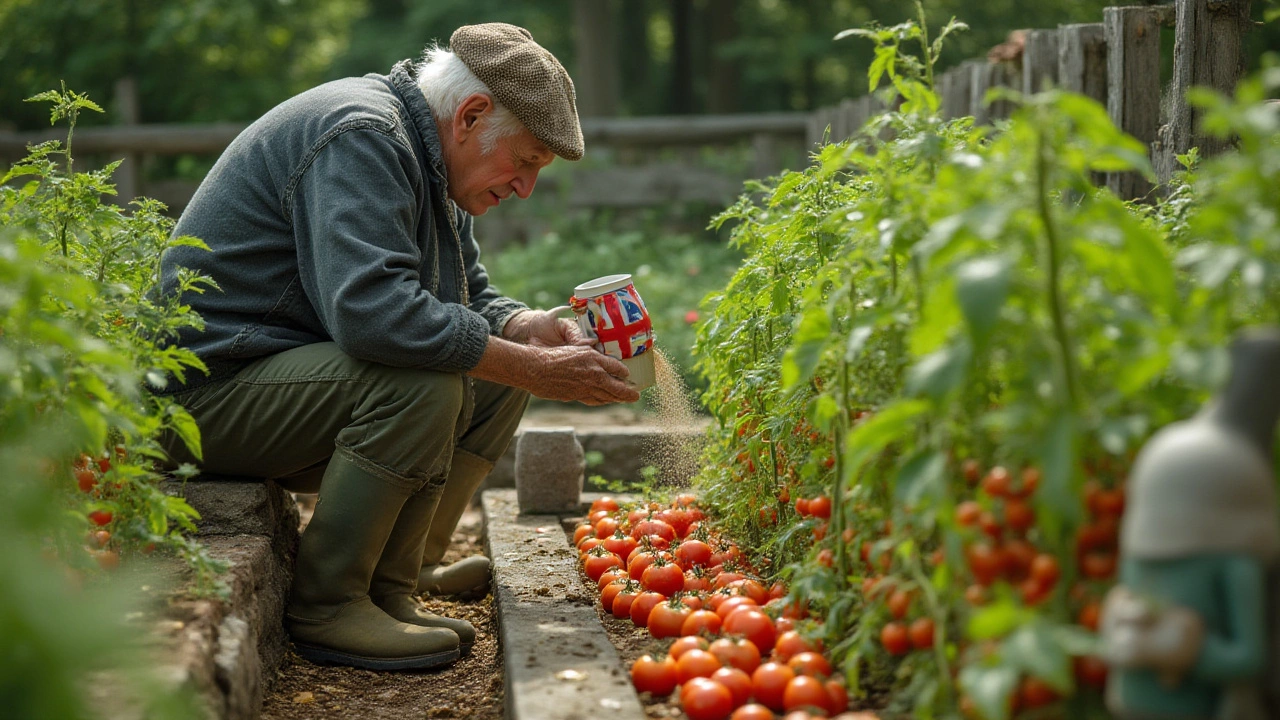The weirdest advice I ever got as a young gardener was to dump leftover coffee grounds at the base of my tomato plants. 'It’ll give them a kick,' my neighbor swore, shoveling her morning brew’s remains onto her veg patch like it was gardening gold dust. But does this kitchen habit actually make a difference, or is it just another backyard myth that refuses to die?
Breaking Down the Science: What’s in Coffee Grounds?
Coffee grounds aren’t just random brown rubbish—they’re packed with all sorts of things plants love and, sometimes, what they don’t. Used grounds contain nitrogen, one of the macronutrients essential for healthy plant foliage and growth. You’ll find around 2% nitrogen by volume, and smaller bits of phosphorus, potassium, calcium, magnesium, and trace minerals. That’s not as much nitrogen as a professional fertilizer, but it’s not nothing.
Interestingly, used coffee grounds aren’t very acidic. This goes against what most gardening forums claim. Fresh coffee is acidic, but after brewing, much of the acidity is pulled out with the liquid. Leftover grounds typically hover near neutral to slightly acidic on the pH scale—usually between 6.2 and 6.9. Tomatoes prefer a soil pH between 6.0 and 6.8, so unless your soil is already too acidic, you probably won’t see any dramatic swings just from coffee.
Let’s talk texture. Coffee grounds break down into fine particles. When you mix them straight into soil in large amounts, they can actually cause compaction and slow drainage—turning rich earth into something closer to cement if you’re not careful. However, in small doses or as part of compost, these grounds improve soil structure, boost water retention, and add organic matter that worms and beneficial microbes adore. The secret sauce: moderation, always.
Another thing to chew on: fresh grounds contain caffeine. Caffeine is toxic to many plant seedlings and can suppress the growth of nearby competitors—how coffee plants fend off rivals in the wild. Luckily, once grounds are used, most of the caffeine is rinsed away.
Coffee Grounds and Tomatoes: Miracle or Mess?
Alright, what actually happens when you sprinkle coffee grounds on your tomato patch? Studies carried out by the Royal Horticultural Society and a handful of university extension programs have put this gardening hack to the test. The results: coffee grounds aren’t a magic bullet, but they do offer some perks if you use them right.
Tiny doses—think a thin sprinkle, not a thick mat—can help feed the soil. As the grounds break down, they slowly release nitrogen and other nutrients, giving tomato plants a little pick-me-up over the growing season. This process works even better if grounds are composted first. Worms are especially drawn to coffee: they munch it up, and their castings make one of nature’s best free fertilizers.
Some gardeners swear coffee grounds keep slugs, snails, or ants away from tomato plants. There’s not much hard science to back that up, but lots of anecdotal evidence from plots around the UK and beyond. Coffee’s gritty texture and caffeine residue may be irritating to slimy pests, but results can vary greatly, depending on weather and ground cover. If you’re battling a serious slug infestation, don’t expect coffee alone to solve it—mix it with other organic pest busters.
Problems crop up when you get heavy-handed. Dumping heaps of coffee grounds directly onto the soil forms a thick barrier, blocking water and air from reaching plant roots. You can suffocate your tomatoes or cause patchy, soggy soil that promotes fungal disease. Balance is everything: only apply a light layer or add grounds to your compost pile for best results.
And here’s what you definitely shouldn’t do: replace regular feeding with just coffee grounds. Tomatoes are heavy feeders—they gobble up potassium and phosphorus, especially when producing fruit—and coffee by itself doesn’t provide enough. Think of coffee grounds as a supplement, not a meal replacement.

How to Use Coffee Grounds in the Tomato Patch
Want to give coffee grounds a fair shot in your tomato garden? There’s a right way, and a wrong way. Let’s walk through the steps.
- Compost first for best results. Chuck used coffee grounds onto your compost heap, layered with kitchen scraps, cardboard, and grass clippings. Give it a few months—the composting process breaks down the grounds’ finer particles and evens out their nutrients. Once the compost is rich, dark, and crumbly, dig it into your planting bed or use it as a mulch.
- If you’re itching to skip the wait, sprinkle a thin layer of dry coffee grounds directly around your tomato plants—but never let it pile up. A handful per plant, gently raked in, is plenty for a feeding boost.
- Mix coffee grounds with leaf mould, well-rotted manure, or wood shavings for a balanced mulch that won’t choke your soil. This blend attracts earthworms, encourages beneficial bacteria, and keeps the soil moist through sunny spells.
- Avoid dumping wet, clumped grounds anywhere. They form a crust that blocks water and suffocates roots. Dry them out in a tray before spreading, or blend them into existing mulch layers.
- Skip using coffee if your soil is already acidic (below pH 6). Tomatoes like a bit of acidity, but not too much. You can test your soil with pH strips from any garden centre.
- Don’t try to water tomato plants with leftover black coffee—used grounds only! Brewed coffee is far too acidic and concentrated for direct use.
- If you’re only drinking instant coffee at home, sorry—skip the grounds. Instant granules lack the plant-friendly goodness found in real used coffee.
One thing many tomato growers in Brighton and elsewhere have discovered: mixing spent coffee grounds with eggshells creates a dual-edged boost. The grounds slowly feed the soil with nitrogen, while crumbed eggshells add precious calcium, helping to prevent blossom end rot—a common tomato woe where fruits develop black, sunken patches. Just be sure eggshells are crushed finely to break down faster.
Common Myths About Coffee Grounds and Tomatoes
No gardening tip seems safe from exaggeration, does it? Coffee grounds are no exception. Here are the most common tall tales, and what the facts really say.
- 'Coffee grounds make soil too acidic for tomatoes.' False! Most spent grounds are nearly neutral in pH. It takes ridiculous amounts to move soil acidity, much more than most home gardeners would ever use. Unless your garden is already pushing below pH 6, this isn’t a big deal.
- 'Coffee grounds instantly fertilize tomato plants.' Not true. The nutrients in coffee grounds release slowly as they decompose. It’s a long game, not a quick fix.
- 'Tomatoes grow faster and bigger with coffee.' Maybe a little, but only if grounds are used as part of a balanced feeding routine. Feeding tomatoes just coffee grounds won’t match the results you get with full-spectrum organic fertilizers like fish blood and bone, composted manure, or seaweed extract.
- 'Coffee keeps all pests away.' There’s some anecdotal truth—slugs and ants may steer clear. But it’s no guarantee. If blight, whitefly, or aphids strike, you’ll need a proper control strategy.
- 'The more coffee grounds, the better.' Big mistake. Excessive grounds block airflow, repel water, and can even trigger fungal growth. Err on the side of less, or let composting do the heavy lifting.
- 'Coffee grounds provide everything tomatoes need.' Not remotely. Tomatoes require phosphorus and potassium for flowering and fruiting, nutrients coffee grounds offer in smaller amounts. Supplement with other organic feeds or balanced fertilizers, especially once the plants begin to flower.
Plenty of these myths show just how desperate most gardeners are for easy answers. The reality is—every garden is unique, shaped by climate, soil, weather, and your own inputs. What works wonders on one plot may do nothing on another. The only way to know? Keep experimenting, and don’t take slick-sounding hacks at face value.

Tips from Brighton’s Tomato Growers: Real-World Experiences
If you dig around in Brighton’s allotments or peek in on local gardening forums, you’ll find no shortage of stories—some wild, some sobering—about using coffee grounds with tomatoes. Plenty of green thumbs here make it part of their annual routine, especially when paired with other organic kitchen scraps. You’ll see buckets of grounds collected from local cafes, sometimes shared out among allotment members, destined for compost heaps and veggie beds.
One plot-holder at the Stanley Road Allotments swears by a mulch that’s one part coffee grounds, one part autumn leaves, and a little sand to keep things loose. His tomato yields consistently outpace his neighbors, though he’s quick to admit it’s not just about coffee—timely watering, good staking, and choosing disease-resistant varieties also help.
Others have tried layering thick, wet grounds around their tomatoes, only to find stunted growth and weird smells. The lesson: moderation and aeration matter most. When worm populations thrive (and they love coffee, if not buried in it), tomato roots seem healthier and less prone to rot.
Several gardeners here have compared beds with and without coffee-treated compost over a season. The beds with composted coffee grounds usually held moisture longer during Brighton’s dry spells, and the fruits were slightly bigger, on average. But skipping potassium-rich feeds sometimes led to lots of leafy growth and not enough ripe tomatoes, proving again that coffee isn’t a stand-alone solution.
For anyone keen to try, some Brighton growers suggest drying grounds thoroughly before use. Spread them on a tray in the sun or a warm windowsill—a quick stir helps prevent mold. Only add to the soil when dry and crumbly, mixing lightly to avoid a dense, water-repelling layer. Their top tip? Observe, adjust, and note what works for your microclimate—no two tomato beds are ever exactly the same, even side by side.
The common thread running through these stories is simple: Coffee grounds can be a useful supplement in the fight for plump, juicy tomatoes, but they aren’t a miracle fix. Use them with a dash of caution, a pinch of patience, and always as part of a well-rounded approach. Tomatoes love good food, good water, and good company (hello, basil!). Coffee grounds might give you that little edge you’ve been seeking—but as with any kitchen scrap experiment, the garden will tell you the truth in the end.
